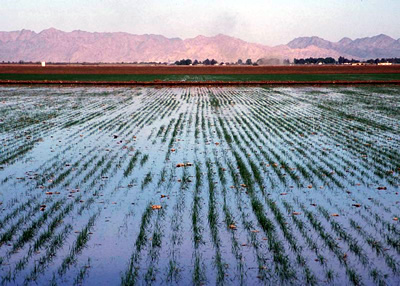About 75 per cent of the Earth's surface is covered by ocean. Of the remaining 25 per cent, most is too cold, too dry or too steep for agriculture.
Only about 11 per cent of the land area is sufficiently warm, moist and level to be used for arable farming, and about twice as much is under permanent pasture or meadow.
The actual proportions vary from continent to continent and from country to country, with Europe being the best endowed with agricultural land. But even though in countries such as Denmark the percentage of arable land is more than 60, other parts of Europe suffer from aridity or permanently frozen ground, and only about one-third of the continent is arable.
South America and Australasia suffer from much more severe limitations, and only about 15 per cent of their land area is suitable for growing crops.
Population and Increased Farming
Large new areas of farmland in the North American prairies and the Argentinean pampas were brought under agriculture during the late 1800s and early 1900s. These regions were used mainly for growing wheat and for raising livestock.
European settlement there and in other parts of the world such as Australia and New Zealand, where a large dairy and sheep industry was established, led to a rapid expansion of the total farmed area and in food production. Sugar cane, cocoa, rubber, tea and coffee were among the products exported from the new colonial plantations in the tropics.
In countries with large populations and small surface areas, such as the Netherlands, reclaimed land has also been farmed. The arable area of the world doubled during the hundred years before 1970. In 2005 China was recorded as being the world's largest agricultural country, accounting for almost one-sixth of the world agricultural output, followed by the EU, India and the USA.
Climatic and Physical Factors
The climate and physical environment impose limitations on agriculture. Huge areas of Africa, Asia, Australia and America, for example, are desert or semi-desert.
Irrigation can overcome the difficulties that arise from aridity in some regions, but the extent of irrigation is restricted in turn by the availability and distribution of fresh water. Therefore, most large perennial irrigation schemes are found in riverine plains such as the Indus valley in Pakistan.
 As crop breeders produce new fast-maturing strains of plants, the growing of crops may be extended into higher latitudes and altitudes, and into drier regions. In Alberta, Canada, for example, strains of wheat have been grown successfully in the short three-month summer season. Some of the extensions of growth areas have been substantial at the local level, but dramatic expansion on a global scale is less likely because many of the climatic limitations on agriculture are unyielding and beyond our control, especially with doubts being cast on genetically modified foods.
As crop breeders produce new fast-maturing strains of plants, the growing of crops may be extended into higher latitudes and altitudes, and into drier regions. In Alberta, Canada, for example, strains of wheat have been grown successfully in the short three-month summer season. Some of the extensions of growth areas have been substantial at the local level, but dramatic expansion on a global scale is less likely because many of the climatic limitations on agriculture are unyielding and beyond our control, especially with doubts being cast on genetically modified foods.
Deficiencies in the soil may sometimes be rectified by, for example, the use of artificial fertilizers and the application of trace elements. Rapid loss of soil from steep mountain slopes can also be overcome - at great expense and in small areas - by terracing. This solution is not practicable for large areas, however, and is worthwhile only if enough water is available.
Increasing areas of arable land are suffering from soil erosion, or from the accumulation of salt or insoluble minerals, as a side-effect of irrigation. Soil is eroded from most cropland faster than it forms and is therefore a wasting asset.
The rate of soil loss varies from area to area and in some places poses a real threat to continued cropping. The amount of land lost to salinization or alkalinization is usually small but significant, because such irrigated regions often produce high yields. In Pakistan, 60,000ha of irrigated land is estimated to have been affected by salinization.
Arable land is being lost mainly as a result of the growth of towns and cities. It is thought that around two per cent of the arable area was built over between 1970 and 2000, and this area, assuming average yields, was capable of feeding nearly 85 million people.
In addition the land lost in the vicinity of urban areas increasingly has to be replaced, if it can be replaced at all, by the recovery of marginal land in remote areas where until recently there was insufficient demand to bring the land under cultivation.
Because the area of land used to grow crops can be increased only slightly and slowly, increased yields will be necessary if the growing world population is to be fed.
Higher yields may be achieved by advances in plant breeding (to produce crops that mature sooner and yield more), by the increased and improved use of fertilizers, and by the greater use of natural pesticides to safeguard crops. But fertilizers are expensive and their widespread use is sometimes detrimental to wildlife.
In developed countries yields have quadrupled since World War II, but agricultural systems have required a great deal of capital and fossil fuel, which in the poorer developing countries are not always assured. The outlook for the world food supply is therefore uncertain. The arable area is probably incapable of great expansion because of environmental limitations and because of other demands for land.